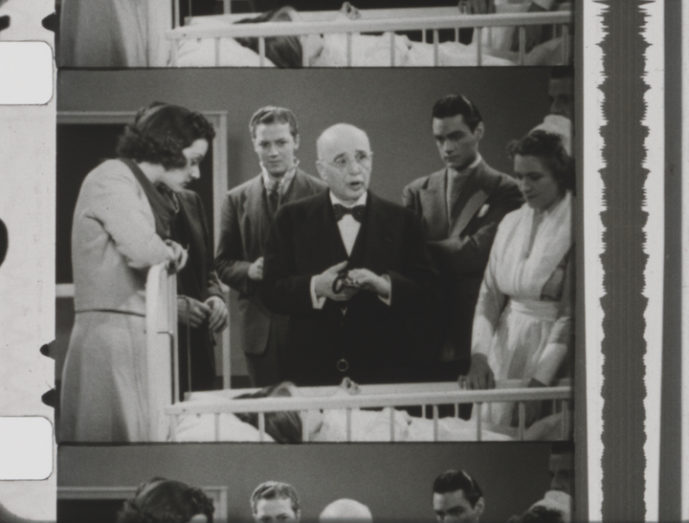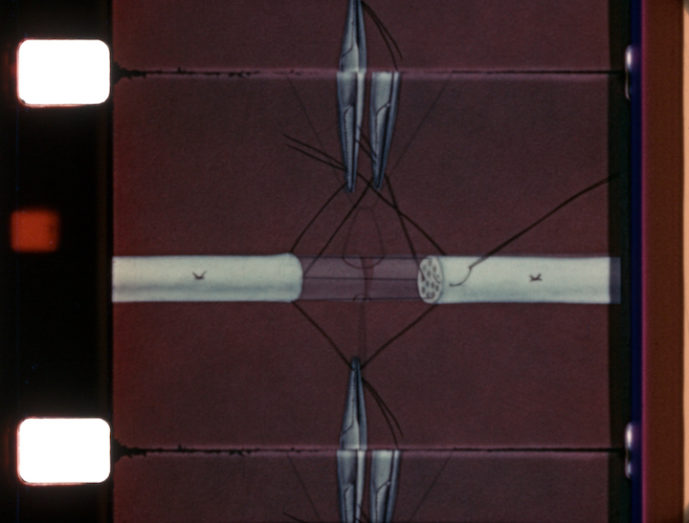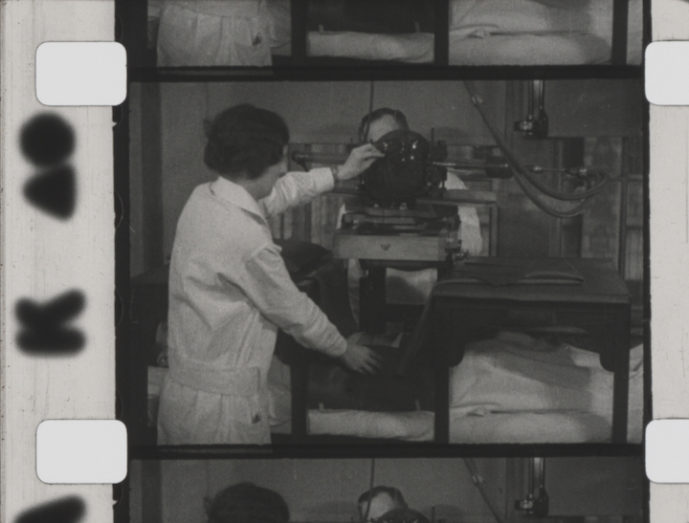Click here to print
Life Support for Medical Films
posted March 2, 2022
Northwestern University’s medical library is reviving a collection of historical educational films of operations, dissections, and other procedures.

Pneumonia: A Pediatric Clinic, 1938. Black and white sound film by Isaac A. Abt. An interactive presentation in which Abt lectures on pneumonia in children, demonstrates a physical examination on a 28 month old patient, and has the students perform the same exams.
Watch films of medical students dissecting cadavers, and you may imagine you can smell formaldehyde. But if the films are from the 1930s to 1950s, the more bracing odor for moving-image librarians will likely be that of vinegar.
That characteristic smell of film-stock decay greeted Katie Lattal and her colleagues at Northwestern University when they located an unusual collection of medical films.
They found that the films were almost all in their original canisters, some in fairly good condition, but many were deteriorating. “Some were rather dark, some a bit hard to see, maybe due to their original condition, and there was also a lot of vinegar condition,” says Lattal, a special collections librarian at the Galter Health Sciences Library & Learning Center at Northwestern’s Feinberg School of Medicine.
Last year, the project to preserve the collection through digitization and public display attracted a grant from the Recordings at Risk program of the Council on Library and Information Resources. The CLIR is an independent, nonprofit organization that collaborates with libraries and other cultural institutions to create ways to enhance research, teaching, and learning strategies.
In the project, Medical Education on Film: Preserving the Medical Motion Pictures (1929-1959) of Northwestern University Feinberg School of Medicine, Lattal and her colleagues have had 82 reels digitized. They were shot between 1929 and 1959. Now Lattal and colleagues are in the process of determining which of the films can be made available online for access by researchers, library patrons, and potentially the general public.
The archivists’ consideration of who should be able to view various categories of the films is one challenge that archivists face when they deal with medical films. Some of them may raise privacy concerns; some may shock many viewers, not least those that depict varieties of animal medical experimentation that will not be as accepted now as it might have been decades ago.
“We didn’t know what was on a lot of the films until we got them digitized,” Lattal says.
Discovered through disease
Ironically, it was disease — Covid-19 — that set her thinking about the films. “It’s a project I started to think about when the pandemic hit,” she says. “We were all sent home to work, and the first few months were a very strange time. I started to think of projects for when I’d get back to the library. At the time, our rare-book collection was offsite due to renovations, and the films were on-site with other artifacts. I noticed them in an inventory, and started to look into them more, and got more and more interested. Knowing that film is fragile and deteriorating, I thought it would be a good thing to get some grant money, to work on the collection.”
She had the films cleaned, stabilized, and digitized to create preservation, production, and access copies with metadata. She and colleagues have been creating finding aids and descriptions for the film, to attach to the digital files.
Not many of the films will likely be used in medical education, nowadays, Lattal concedes, but their interest to medical educators and historians of medical education will remain. The films will also be sure to interest medical filmmakers, medical imagery technicians with an eye towards the history of surgery and medical research, and others.

Injuries of the Peripheral Nerves, 1948. Color and sound film, directed by Loyal Davis, MD, and George E. Perret, MD. Produced under a grant from Johnson & Johnson Research Foundation. Produced by Mervin LaRue, Inc. In this still, they use animation to the healing of a nerve after surgical repair of a peripheral nerve. I tried to get a still in the middle of the animation, since the section in the middle goes from fully transparent to bright white to signal the healing. All images: Galter Health Sciences Library & Learning Center, Feinberg School of Medicine, Northwestern University
The project is particularly appropriate to the Feinberg School of Medicine because the institution was an early adopter of the mid-20th century trend of including film in curriculums, so much so that in 1941 Feinberg established its own Department of Visual Medical Education.
The department screened films for interested faculty members at Northwestern University and also managed a film rental service — films were sent to all reaches of the United States. The department also facilitated collaborations between faculty members and filmmakers, prominently Mervin LaRue, of Chicago.
The films depict procedures, conditions, and research in surgery, obstetrics, ophthalmology, pediatrics, and other fields. For example, says Lattal, “you see different surgeries, a few that are animated, that show the processes of an internal organ.”
Among points of interest for medical faculty members today, she says, is the way surgeries were performed in earlier times — often, rapidly, due to limitations and conditions of the day. “One of our doctors sent us a comment about how fascinating one film was to watch as a modern-day surgeon because the film was of someone operating on a heart in the early 1950s, and the surgeon had to work very, very quickly compared to now, with better clotting medications and so forth.” A film like that conveys poignantly the “life and death” nature of surgery at the time, she says.
Many films “strive not to show the identity of the person being depicted if surgery is being done. They did think of that in terms of ethical considerations.”
Many of the films may have been weeded out of collections as they became outdated, or set aside and forgotten. “Many had found their way to the Galter Library definitely before 1980, but I can’t say with certainty how much before that,” Lattal says.
Her own favorite among the films, she says, is an informational, promotional silent film about the Feinberg School of Medicine made in about 1939. It moves through various departments of the med school, showing what was happening in them. “You see people working — taking an X-ray, for example. You see the Institute of Neurology with people working with microscopes and preserved brains. You see people lining up at the school’s free medical clinic. And students working on cadavers. It’s a really fascinating snapshot. It’s all staged, and silent, but it was spoken to when it was presented.”
Some animals did suffer in the making of some films
Many of the procedures shown, particularly involving research on animals, would likely not be performed, nowadays, nor filmed, Lattal says. “A lot of the films carry quite graphic content and are definitely a product of their time.”
One remarkable figure involved in the filmmaking was Joseph B. DeLee, an avid adopter of motion pictures for medical education. “He’s a person who has some good legacies and some quite bad legacies in his practices,” says Lattal. “He’s a character ripe for attention.” Sometimes called “the father of modern obstetrics,” and a pioneer of using medical films as teaching tools, DeLee made films of, for example, live births. He used those to familiarize students with a phenomenon they might otherwise not become properly familiar with until confronted with the real thing. But DeLee courted controversy not only by advocating for the replacement of midwives with obstetricians — a key moment in the professionalization of American obstetrics —but also by classifying childbirth as akin to a disease requiring treatment.

Northwestern Marches On!, c. 1929. Black and white silent film created by the medical school. It was likely made to show off the brand new medical school building, finished in 1926. This still shows technicians operating an x-ray machine.
To address concerns about who should appropriately view various of the films, Lattal and colleagues are affixing codes to film files, or just “graphic content” warnings. Viewers will be able to watch the films via a Galter Library online repository. Some titles will likely be shared via the Internet Archive (archive.org) and YouTube, which have their own graphic-content controls. The archivists are consulting with Northwestern’s Center for Bioethics and Medical Humanities about what will be most appropriate.
The CLIR grant was awarded in part to “create a buzz about the films,” says Lattal. So she’ll send word to listservs as well as medical-heritage and Chicago-oriented organizations like the Chicago Collections Consortium.
Lattal says: “I hope that people start to look at educational film as something to be more thought about. In the United States in the 1950s, you could find educational films in every classroom, from grade school through high school and right up to medical schools. So it was quite relevant to how generations of people were educated.
“Our collection provides insights into what that was like.”
— Peter Monaghan
Printed from Moving Image Archive News: https://www.movingimagearchivenews.org
URL to article: https://www.movingimagearchivenews.org/life-support-for-medical-films/
Click here to print